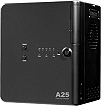 |
Fuel Cells for Power |
 |
Fuel Cells for Power |
|
|
Direct Methanol Fuel Cell (DMFC) A Direct Methanol Fuel Cell (DMFC) is a subset of the PEM fuel cell family that uses methanol as its primary fuel without the need for a reformer. In many PEM fuel cell applications, reformer technology is utilized to remove hydrogen from fuels such as propane, gasoline, or diesel fuel. The pure hydrogen is then introduced to the PEM fuel cell to begin the chemical reaction resulting in electricity. DFMC’s are supplied directly with methanol and produce electricity from a chemical reaction between methanol, water, and air resulting in small amounts of water and carbon dioxide. DFMC’s are seen as a candidate to eventually replace lithium-ion battery technology in consumer electronics due to the fact that they typically can produce a high amount of energy in a small space over a long period of time. The advantage DFMC’s have over lithium-ion batteries is the fact that they can continue to produce power as long as there is fuel present. Instead of recharging this power source, the user only needs to insert a new methanol cartridge to continue to power the laptops, cellular phones, or MP3 players that may eventually be outfitted with fuel cell power paks. Commercial DFMC’s will have a longer operating time when compared to lithium-ion batteries of similar size and can be instantaneously recharged by replacing a disposable fuel cartridge. |
|
||
|
|
||||
|
|
 EFOY 600, 1200, and 1600 Fuel Cells 44cm x 20cm x 28cm 7.5 kg  5W Antig A5 Fuel Cell 150mm x 25mm x 105mm 300g  25W Antig A25 "Cube" 176mm x 210mm x 156mm 3kg  50W Antig A50 "Brick" 280mm x 130mm x 110mm 5kg |
Using methanol as a primary fuel has its advantages over pure hydrogen. One of the most significant is that fact that methanol can be stored as a liquid over a wide temperature range (-97oC to 64.7oC ) and therefore avoids many of the pitfalls of hydrogen storage. In order to use hydrogen effectively, it has to be highly pressurized in gaseous form or supercooled to a liquid. Hydrogen gas must be contained in high pressure tanks, usually lined with an expensive composite coating to avoid reacting with and weakening the metal tank itself. The weight associated with hydrogen storage tanks and the low energy density by volume of hydrogen gas, coupled with the expense of producing hydrogen, make its use as a energy producer difficult to justify. Liquid methanol on the other hand can be stored in cheap plastic containers and is an excellent carrier fuel that hydrogen can be extracted from to power fuel cells. Pure methanol, because it exists in liquid form, also has a significant energy density by volume advantage over highly compressed hydrogen gas allowing DFMC’s to exist in a very compact form. This size factor makes DFMC’s ideal for consumer electronics, but probably prevents their use in vehicle propulsion applications. Commercial DFMC’s will function best as a battery-fuel cell hybrid. Most portable electronics vary in their power consumption needs over the course of normal use. At certain times, such as during initial start up, high inrush current is required. Then as the device settles into steady-state operation, only a simple trickle charge is necessary. Battery technology responds to this type of power demand very efficiently whereas fuel cells produce a constant power over a given time. By combining the two, the battery will have the capability to provide the additional that’s required when demand is high and the fuel cell will maintain a constant power as the device returns to steady state. Any excess power not needed by the device during normal operation will go into recharging the battery so it is ready for the next peak power requirement. Direct Methanol Fuel Cell Chemical Reaction To create power in a DFMC fuel cell, a mixture of water and methanol is introduced to the fuel cell. Methanol is oxidized on a catalyst layer usually containing platinum to form carbon dioxide. Water is actually consumed at the anode in the reaction with methanol that produces carbon dioxide and a set of positive hydrogen ions and electrons. The positive hydrogen ions (H+) pass through the proton exchange membrane and the electrons are transported from the anode to the cathode through an external circuit to supply power to external devices. At the cathode, oxygen from the air combines with the positive ions and electrons to form water molecules. Because water is consumed at the anode as part of the chemical reaction, in many cases pure methanol cannot be used thereby reducing the energy density of the fuel. The other current technology deficiency is that fact that some methanol will directly pass through the membrane without producing electricity, resulting is what is called methanol crossover. The resulting efficiency of DFMC’s is generally close to about 40%. Commercially Available COTS DMFC Fuel Cells The following is a list of companies that produce commercial off-the-shelf (COTS) fuel cell products that can be purchased to address a variety of DMFC power provision applications. SFC Smart Fuel Cell AG / EFOY - SFC is a German company that produces a line of fuel cells in 25W, 50W, and 65W variations for the purpose of charging lead-acid batteries. Each fuel cell uses methanol as its fuel producing 12-volts DC. MTI Micro – MTI Micro has developed some rather interesting compact fuel cell devices that can be imbedded into commercial products. MTI Micro’s Mobion technology is their flagship technology for DMFC commercial product integration. Oorja Protonics – Oorja has created a very specific onboard methanol fuel cell battery charger aimed at the materials handling industry, for use in electric forklifts, pallet trucks, and automated guided vehicles. The OorjaPac trickle-charges the vehicle’s battery while the vehicle is operating and while it is parked thereby eliminating the need for the time-consuming recharge operating that shelve pieces of equipment for hours at a time. Antig – Antig produces a line of methanol fuel cells to power commercial electronics. Based out of Taipei, Antig produces and sells 5W, 25W, and 50W with output voltages ranging from 5 – 24 VDC. The Down Side of Methanol For its many advantages over hydrogen as the next great savior of fuel cell technology, using methanol as a universal fuel causes grave concern due to its affect on the human body. Methanol can enter the body through ingestion, inhalation, or absorption through the skin. Exposure to methanol can cause blindness and birth defects as it attacks the optic nerve and destroys fetal tissue. Furthermore, chronic exposure over time can be fatal, therefore those handling methanol without gloves or respiratory protection risk exposure that may cause permanent damage. Methanol’s initial effect on the body is similar to that of alcohol. It’s accompanied by dizziness, blurred vision, nausea, confusion, and lack of coordination, but quickly becomes more debilitating as it is absorbed by the kidneys and liver. Methanol is flammable and burns with a colorless flame that can be difficult to detect. It is also highly soluble in water and unlike gasoline, which floats on water, can seep into the ground to contaminate water tables and drinking water supplies. Methanol can be very dangerous and extreme caution should be taken as we more forward to integrate the use of Direct Methanol Fuel Cells into commercial products. Direct Ethanol Fuel Cell (DEFC) Another derivative form of the Direct Methanol Fuel Cell is the Direct Ethanol Fuel Cell (DEFC). The DEFC is very similar to the DMFC in concept and operation. However with the DEFC, ethanol is used as the hydrogen carrier fuel directly introduced to the modified PEM fuel cell to produce electricity. Ethanol is also the greener of the two alternatives. It can be produced from biomass and is non-toxic in nature unlike methanol which is flammable and quite toxic. Being non-toxic eliminates the need to worry about clean up efforts in the event of a chemical spill, which accounts for part of ethanol’s appeal with environmentalists. Ethanol can be produced by a fermentation process utilizing renewable resources such a corn, wheat, or sugar cane. This bio-generated ethanol is an attractive alternative to fossil fuels since growing crops absorbs enough carbon dioxide in the air to offset a significant portion of the carbon dioxide generated in producing the biofuels in the first place. Ethanol’s existing a supply chain will also make it easy for customers to readily access the fuel. The major limitation of the DEFC however, is that it runs at close to 50% the efficiency of the DMFC, but there continue to be researchers looking into both alternatives in order to optimize a fuel cell design which utilizes these fuels. |
|
|
A Production of Madness
Unwatched LLC |